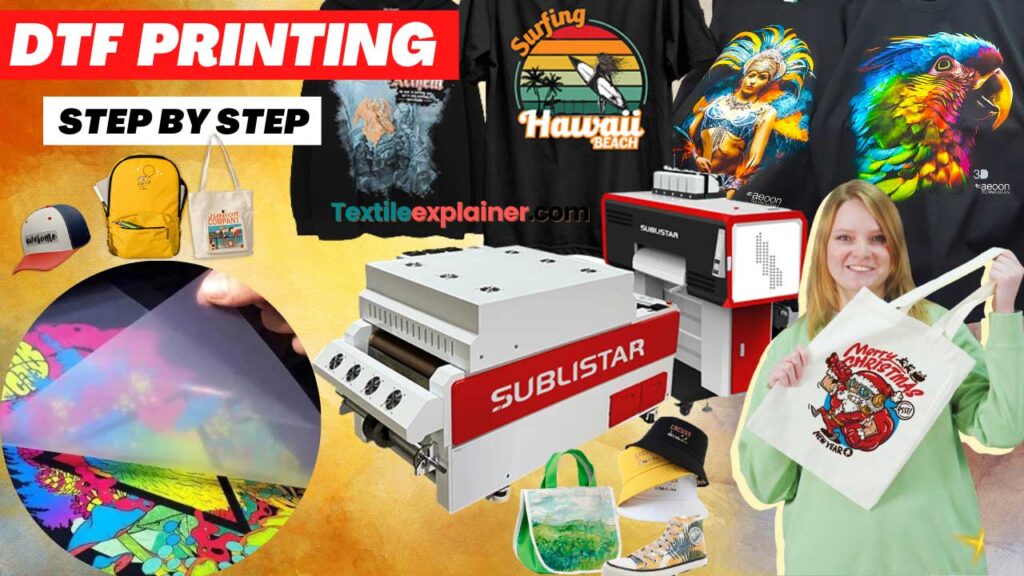Ultimate Guide to DTF Printing Strategies for Stunning Fabric Styles
Starting the journey of mastering DTF printing strategies can open up a world of possibilities for creating aesthetically fascinating textile styles. As the textile industry remains to advance, staying ahead of the contour with innovative printing methods is necessary. In this overview, we will certainly explore the elaborate details of DTF printing, from grasping the essential basics to unraveling progressed color strategies that can boost your layouts to new elevations. Remain tuned as we dig into the subtleties of choosing the best materials, refining the printing procedure, and getting rid of usual obstacles to accomplish spectacular outcomes.
Recognizing DTF Printing Basics
DTF printing, a procedure that includes transferring designs from a special film to textiles using warm and stress, forms the structure of textile printing strategies. The first step in DTF printing involves developing or picking a style that will certainly be printed onto the fabric.
Once the layout is published on the movie, it is after that very carefully put onto the fabric, making certain proper placement and positioning. The following important action entails applying warmth and stress using a heat press device. This procedure triggers the dyes or pigments on the movie, creating them to sublimate and bond with the fabric fibers completely. The outcome is a sensational, lasting textile design that is washable, versatile, and resistant to fading. Overall, understanding the essentials of DTF printing is crucial for grasping this modern-day fabric printing strategy.
Choosing the Right Fabric Materials
Having actually established the foundational principles of DTF printing methods for textile styles, the following important factor to consider exists in choosing the appropriate fabric materials to match this ingenious process properly. In addition, the stretchability of these materials can suit the warm transfer process included in DTF printing without distorting the design. By selecting the best textile products, designers can make best use of the possibility of DTF printing to create resilient and sensational fabric designs.

Understanding the Printing Process
To succeed in DTF printing techniques for fabric designs, mastering the printing process is crucial for achieving regular and premium results. The printing process in DTF includes numerous vital actions that require precision and attention to information. Preparing the artwork for printing is important. This consists of guaranteeing the style is properly sized and placed for the textile. Next, the style is published onto an unique DTF movie utilizing a suitable printer with the right settings to accomplish ideal color vibrancy and clarity (DTF Printing). Once the style is published, it is after that moved onto the material utilizing a warmth press machine. The temperature, stress, and period of warm application need to be carefully controlled to guarantee proper adhesion of the layout to the fabric. Additionally, grasping the peeling procedure after warmth pushing is vital to stop any damages to the layout or material. By developing each of these action in the printing procedure, designers can consistently generate spectacular and long lasting Visit This Link textile layouts with DTF printing methods.
Enhancing Styles With Shade Techniques

Additionally, explore shade gradients can bring a sense of activity and fluidity to the design. By blending colors perfectly, a slope result can be attained, including a dynamic and modern touch to the textile design. Furthermore, using color blocking strategies can produce strong and striking visuals by juxtaposing different solid colors in distinct areas of the layout.
Moreover, including metal or neon colors can provide a unique and appealing element to the fabric style, making it stand apart and emanate a feeling of vibrancy. When strategically applied, these color methods can boost the overall aesthetic charm of fabric layouts, making them much more captivating and memorable.
Troubleshooting Common DTF Printing Issues
After discovering different color techniques to enhance textile layouts, it is necessary to attend to common DTF printing issues that might arise during the production procedure. One typical issue is poor attachment, which can result from improper healing temperatures or times. To solve this issue, ensure that the treating setups are accurate which the glue used is ideal for important source the particular textile being published on. One more regular challenge is color incongruities, where colors might appear in different ways than expected. This can be brought on by wrong shade profiles or setups in the printing software. To tackle this, confirm the shade setups and accounts to guarantee they match the intended design. Furthermore, problems with photo clarity and intensity can occur because of low-resolution photos or inappropriate printing techniques. To address this, always use high-quality images and change the printing settings for ideal quality. By recognizing these usual troubles and executing the needed troubleshooting actions, you can improve the overall high quality of your DTF published fabric styles.
Final Thought
Finally, mastering DTF printing strategies is necessary for producing spectacular textile layouts. By recognizing the essentials of DTF printing, picking the ideal materials, and enhancing layouts with color methods, one can attain impressive outcomes. It is essential to fix common concerns that may emerge during the printing process to make sure a successful outcome. With practice and focus to detail, one can develop lovely and special textile designs utilizing DTF printing techniques.
DTF printing, a process that entails transferring styles from a special film to textiles making use of warmth and pressure, creates the structure of textile printing strategies.Having actually developed the foundational principles of DTF printing strategies for fabric designs, the next critical factor to consider exists in selecting the proper fabric materials to match this cutting-edge process effectively. By selecting the best fabric products, developers can optimize the capacity of DTF printing to develop sensational and lasting fabric designs.
To excel in DTF printing methods for fabric layouts, mastering the printing process is crucial for accomplishing regular why not try these out and premium results. DTF Printing. By sharpening each of these steps in the printing process, designers can continually create sturdy and spectacular fabric designs with DTF printing strategies